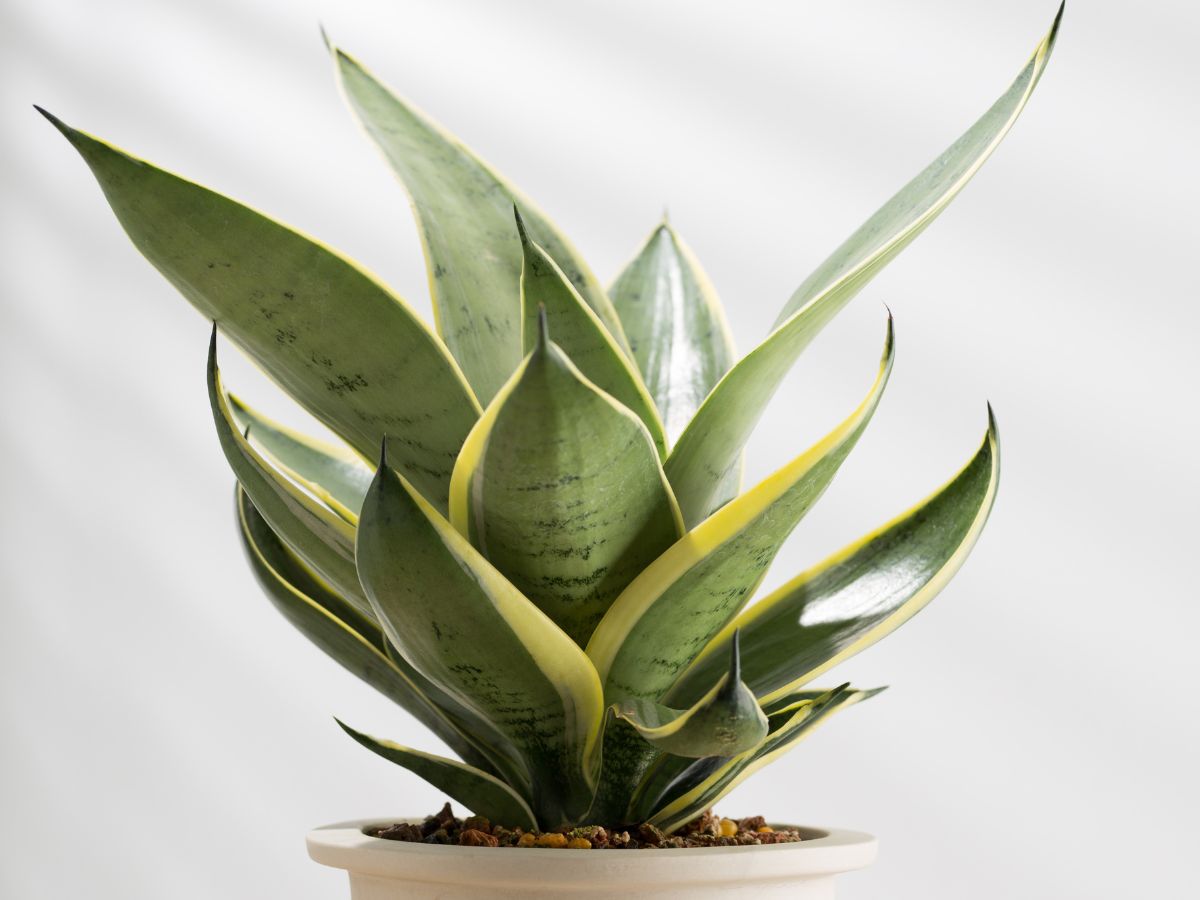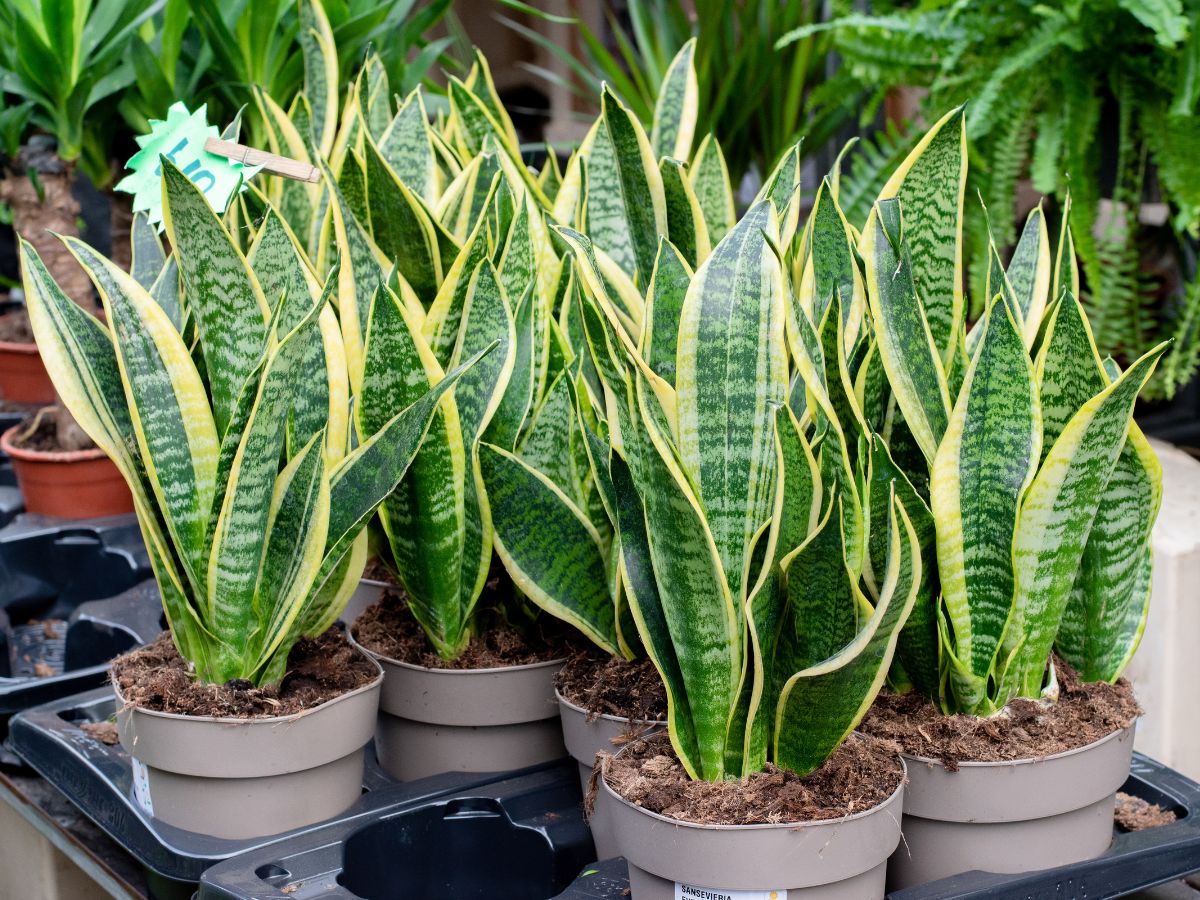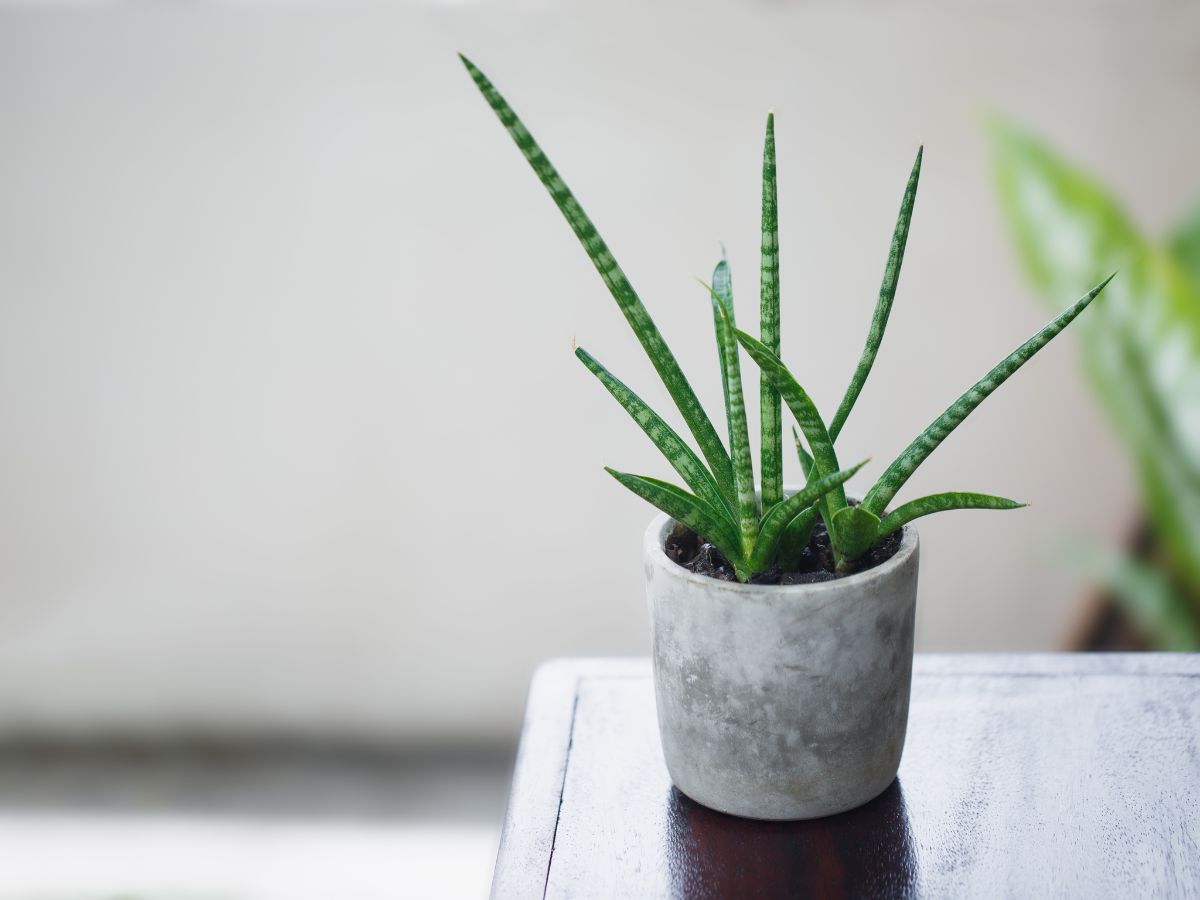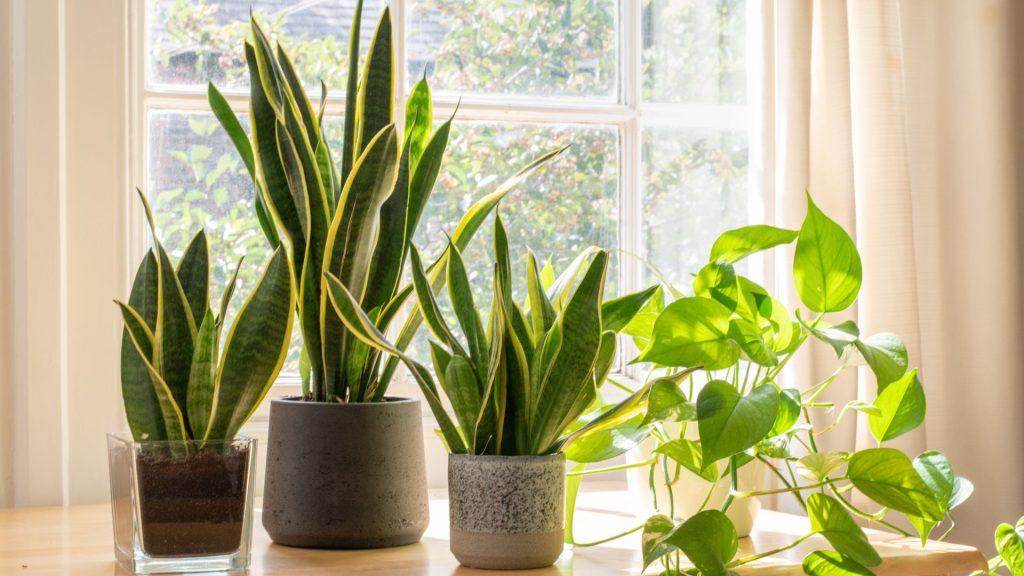The Snake Plant, official name: Sansevieria Trifasciata, otherwise known as Mother-In-Law’s Tongue or St. George’s Sword has been increasing in popularity throughout the years, and most recently it has been the go-to houseplant for many of us prone to (accidentally) letting plants die. This is because of the Snake Plants’ robust and adaptable nature. That being said, it is still highly important to understand how to care for a Snake Plant.
Before learning the ins and outs of how to care for Snake Plant varieties, we must first establish a clear understanding of what a snake plant is and be able to identify the many types of snake plants.
What Is a Snake Plant?

Snake Plants are a highly resilient succulent, well known for not only looks incredible but also for providing health benefits to those who keep them indoors. (Especially in the bedroom).
Snake Plants have the ability to help purify the air around them. They are skilled at absorbing Carbon Dioxide (CO2) and can then convert it into oxygen at night, leaving you with fresh, crisp airflow inside your home. These plants are great for people with airborne allergies thanks to their air-purifying properties.
If that wasn’t enough to convince you of how wonderful a Sansevieria is, then this surely will – snake plants are extremely easy to care for! They adapt well to a range of lighting conditions and barely need any water, so it’s ok if you’ve got a memory like a sieve and forget to water your snake plant every now and again. It won’t cause any real damage.
Types of Snake Plants
Bird’s Nest Snake Plant

- Botanical Name: Sansevieria Trifasciata Hahnii
- Origin: Subtropical Africa
- Visual Features: Dark glossy, funnel-shaped leaves
- Other: Suitable for varied levels of light however will thrive and become more vibrant in high-level indirect sunlight
Variegated Snake plant

- Botanical Name: Sansevieria Trifasciata Laurentii
- Origin: Tropical West Africa
- Visual Features: Yellow outlines around the leaves with an almost striped green pattern
- Other: This is the most commonly recognized snake plant. It can adapt to low-lighting. It is a slow-growing plant
Cylinder Snake Plant

- Botanical Name: Sansevieria Cylindrica
- Origin: Angola
- Visual Features: Tall cylindrical leaves that appear almost spear-shaped
- Other: Very low maintenance plant that, like other snake plants, is mildly toxic when consumed (so keep away from children and animals!)
How to Grow Snake Plant?
Whilst many people choose to purchase a pre-potted snake plant for their home, some of you are probably more interested in learning how to grow Sansevieria Trifasciata from scratch. Below is a step-by-step guide to growing your snake plant.
Step 1. How to Propagate a Snake Plant
Learning how to propagate a snake plant is an incredibly rewarding activity. It allows you to share this easy-to-care-for houseplant with even your most clueless friends. Or you can propagate your plant in order to start your very own snake plant family! Whatever the reason, here’s how to do it:
Find a tall container for the first stage of propagation. Choose a leaf that looks healthy and cut it off at the desired height using sharp shears. Place the leaf into the container with a small amount of water (cover the leaf about ¼ of the way).
Step 2. Potting Your Snake Plant Cutting
Your leaf should now be in a tall container, this is the first potting stage as you need to wait for roots to form before planting it in a sturdy pot. Make sure you change the water every two days to allow your leaf to produce roots. Once you see roots appear, place the cutting in a medium-sized pot with a well-draining system. Use a mixture of cactus soil, sand, and pebbles to really ensure your snake plant won’t drown when watered.

Step 3. How Much Light Does a Snake Plant Need?
Place your snake plant in bright, indirect sunlight – especially in the initial stages of new growth. Once your plant has reached a mature age, snake plants are great at adapting to less light so feel free to move it somewhere more shaded if your feng shui is out of whack!
Step 4. How Often to Water a Snake Plant
Snake plants are quite susceptible to rot, so go easy on the water. Most snake plants only need watering once every month! Do make sure to check on it and allow the soil to completely dry out before watering though. (Don’t worry if you forget to water it, snake plants thrive on neglect!).
Step 5. How to Repot a Snake Plant
You may have found that the pot you initially potted your snake plant in has become too small and the roots are increasingly outgrowing their container. Now to worry! Repotting a snake plant is very simple and has almost no adverse effects if done correctly.
Select a pot that is about 2 inches wider than the current pot and part-fill with the same blend of soil/sand as before. Remove your snake plant from its pot ensuring all the roots are intact. Place your plant in its new home and fill in the remaining space with the leftover soil mix. The water you plant after the transplant and care for your repotted plant as usual.
How to Propagate Snake Plant
Materials Needed
- Healthy snake plant
- Clean knife or garden shears
- Well-draining soil mix
- New pot with drainage holes
- Water
- Optional: rooting hormone, plastic wrap, and stakes

Steps
- Choose a healthy mother plant: Start by selecting a mature and healthy snake plant that has several leaves and well-developed roots. A plant that is at least a few years old will be easier to propagate than a younger plant.
- Prepare the new pot: Fill a new pot with well-draining soil mix. The pot should be slightly larger than the original pot, with drainage holes. You can use a mix of potting soil and sand or perlite to ensure good drainage.
- Remove the plant from the pot: Carefully remove the mother plant from the pot, and gently loosen the soil around the roots. You can use your hands or a garden tool to gently separate the soil from the root ball.
- Divide the root ball: Using a sharp, clean knife or garden shears, divide the root ball into several sections. Each section should have a minimum of three to four leaves and roots. Make sure that each section has its own root system and is not just a piece of stem or leaf.
- Plant the new sections: Plant each section in a new pot, and gently press the soil around the roots. Make sure that the plant is planted at the same depth as it was in the original pot. You can add a small amount of rooting hormone to the soil to encourage root growth.
- Water the new plants: Water the newly planted snake plants thoroughly, and let the soil drain. Make sure that the soil is evenly moist but not waterlogged. You can also cover the pot with plastic wrap to help retain moisture and create a humid environment.
- Provide indirect light: Place the new plants in an area with indirect light, and avoid direct sunlight. Snake plants can tolerate low light conditions, but they will grow best in bright, indirect light.
- Care for the new plants: Allow the soil to dry slightly between watering, and provide adequate humidity. You can mist the plants with water or use a humidifier to keep the air moist. You can also use stakes to support the plants if they are tall or leggy.
- Watch for new growth: In a few weeks, the new plants should start to grow. You can resume normal care at this point and treat the new plants as you would the mother plant. Over time, the new plants will grow into mature, healthy snake plants that you can enjoy for years to come.
Overall, propagating a snake plant is a simple and rewarding process that can help you grow your collection of indoor plants. By following these steps, you can create new plants from an existing mother plant and enjoy the benefits of these hardy and versatile plants in your home.
How Fast Do Snake Plants Grow?
Sansevieria plants are all fairly similar when it comes to the growth rate. They all grow reasonably slowly. Part of the reason Sansevieria makes such good houseplants is because of their slow-growing nature which allows them to not outgrow a space. If your snake plant is exposed to more sunlight you may see a rapid growth spurt however your snake plant will be unlikely to reach taller than 3-4 feet indoors.
Frequently Asked Questions
Are snake plants easy to care for?
Yes, snake plants are very easy to care for. They are tolerant of a wide range of conditions, including low light, low humidity, and infrequent watering. They are also very resilient and can recover from neglect or stress.
Can snake plants survive in low light?
Yes, snake plants can survive in low light conditions. In fact, they prefer indirect light and can even tolerate low light levels. However, they will grow more slowly and may not produce as many leaves in low light.
How often should I water my snake plant?
Snake plants prefer to dry out slightly between waterings, so you should allow the soil to dry before watering. Depending on the conditions in your home, you may need to water your snake plant every 2-4 weeks. It’s important not to overwater your snake plant, as this can lead to root rot.
How can I tell if my snake plant needs water?
You can tell if your snake plant needs water by checking the soil. Stick your finger into the soil up to the second knuckle. If the soil feels dry, it’s time to water. If it’s still moist, wait a few more days before checking again.
Can snake plants be grown in water?
Yes, snake plants can be grown in water. To do this, cut a healthy leaf from the mother plant and place it in a jar or vase filled with water. Change the water every few days to prevent the growth of bacteria. After a few weeks, roots should start to develop, and you can plant the leaf in soil.
Are snake plants toxic to pets?
Yes, snake plants are toxic to pets if ingested. They contain saponins, which can cause gastrointestinal upset, vomiting, and diarrhea in pets. Keep your snake plants out of reach of pets, or choose pet-safe plants instead.
How can I propagate my snake plant?
Snake plants can be propagated by dividing the root ball and separating the individual plants. To do this, remove the mother plant from the pot, divide the root ball into sections, and plant each section in a new pot. Water the new plants and provide them with indirect light until they start to grow.
Conclusion
Snake plants are a great addition to any indoor garden due to their resilience and easy care. With their ability to thrive in low light conditions and tolerate infrequent watering, snake plants are an ideal choice for beginners and experienced plant lovers alike.
Additionally, propagating snake plants is a simple and rewarding process that allows you to expand your collection of these beautiful plants. By following the tips and guidelines provided in this article, you can enjoy the benefits of snake plants in your home and create a beautiful, thriving indoor garden.


